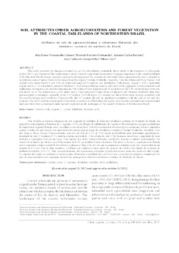Soil attributes under agroecosystems and forest vegetation in the coastal tablelands of Northestern Brazil.
Soil attributes under agroecosystems and forest vegetation in the coastal tablelands of Northestern Brazil.
Autoria: GOMES, J. B. V.; FERNANDES, M. F.; BARRETO, A. C.; ARAUJO FILHO, J. C. de; CURI, N.
Resumo: This study evaluated the changes occurred in a set of soil attributes, particularly those related to the dynamics of soil organic carbon (SOC), as a function of the replacement of native forest for agricultural ecosystems of regional importance in the coastal tablelands of Northeastern Brazil (orange, coconut, eucalyptus and sugarcane). Six commercial sites under these agroecosystems were compared to neighboring areas of native forest in five areas along this region (Coruripe, Umbaúba, Acajutiba, Cruz das Almas and Nova Viçosa). Soil samples were taken from 0-5 and 5-20 cm depth and analyzed for particle size distribution, bulk density, organic C (OC), particulate organic matter, C in soil solution, microbial biomass C, total cation exchange capacity and water stable aggregates. Linear correlation and multivariate techniques were used for data analysis. The values of base saturation and Al saturation for the 0-20 cm depth layer were also calculated. In all the studied areas, soils under native forest presented better status of physical and chemical attributes than their agroecosystem counterparts, especially in the 0-5 cm layer. For both layers, OC content was the attribute most strongly correlated with the overall changes in all attributes. Unexpectedly, the OC content showed no significant correlation with the sum of silt and clay contents. The set of variables investigated in this study is sensitive to differentiate the quality of soils under perennial and semi-perennial land uses from their counterparts under natural vegetation in the landscapes of the coastal tablelands of Northeastern Brazil.
Ano de publicação: 2012
Tipo de publicação: Artigo de periódico
Unidade: Embrapa Florestas
Palavras-chave: C orgânico, Caráter coeso, Coastal Tablelands, Cohesive soils, Organic C, Solo, Solos cauliníticos, Tabuleiros Costeiros
Observações
1 - Por padrão são exibidas publicações dos últimos 20 anos. Para encontrar publicações mais antigas, configure o filtro ano de publicação, colocando o ano a partir do qual você deseja encontrar publicações. O filtro está na coluna da esquerda na busca acima.
2 - Para ler algumas publicações da Embrapa (apenas as que estão em formato ePub), é necessário ter, no celular ou computador, um desses softwares gratuitos. Sistemas Android: Google Play Livros; IOS: iBooks; Windows e Linux: software Calibre.
Acesse outras publicações
Acesse a Base de Dados da Pesquisa Agropecuária (BDPA) para consultar o acervo completo das bibliotecas da Embrapa.

